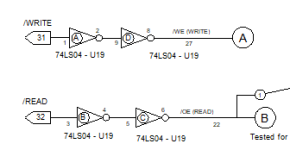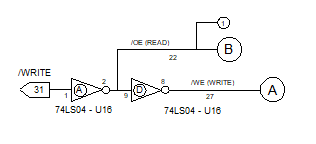It's a complex problem - and for the life of me, I can't work out why it's only happening on read - the closest idea I could come up with was something like RD shorting to a bus gate control like in such a way to cause self-oscillation - eg, a feedback loop -= I really can't think of anything else that would cause high frequency oscillations that look to be an order of magnitude or more above the clock frequency in a logic system. It's like one of the lines ( probably read ) is shorted somehow to another line, and then loops back on itself, so that it shorts, resets, shorts, resets, and so on. Generally the scope image you're seeing can't be created by missing grounds or other signals and I've also seen data lines provide VCC or GND to a chip before through the diode protection network on each pin. But in your case, the oscillations look to be occuring at a higher frequency than the scope quantisation period can handle - ie, a digital logic feedback mechanism. 1
Can you get a higher scan rate image of on of the messed up signals? eg, at 100us per division? Determining the frequency of what you're seeing is a clue also.
Honestly, if you can get to it, run a wire to the same pins on the z80 - I'm pretty sure the signal should be clean there. If it's not, then the z80 is at fault ( Fan out issue maybe? ) - If the z80 is stable, then trace the line through the PC all the way to the card bus and see where the oscilations are first noted, get induced or otherwise start.
Building another card with just the 138 wired up to begin with is as you are suggesting, so that you can generate and test the signals directly before RAM is installed as you proposed is also a good idea.
Your premise and design appear correct, and the use of the logic circuits is also good. The only parallel race condition you had was eliminated, so I think solving the oscillation on read problem is all that's standing between you and a working RAM disk.
I wondered why you were using wire wrap so extensively, and now it makes sense - thanks for sharing the background story there -
David.



